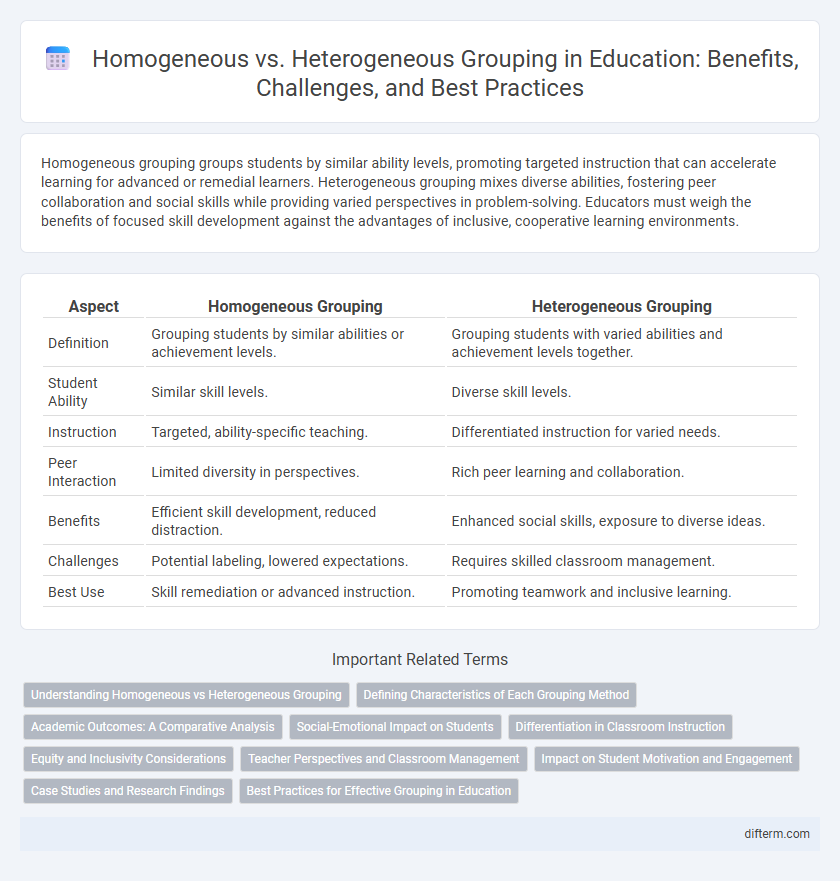Homogeneous grouping groups students by similar ability levels, promoting targeted instruction that can accelerate learning for advanced or remedial learners. Heterogeneous grouping mixes diverse abilities, fostering peer collaboration and social skills while providing varied perspectives in problem-solving. Educators must weigh the benefits of focused skill development against the advantages of inclusive, cooperative learning environments.
Table of Comparison
| Aspect | Homogeneous Grouping | Heterogeneous Grouping |
|---|---|---|
| Definition | Grouping students by similar abilities or achievement levels. | Grouping students with varied abilities and achievement levels together. |
| Student Ability | Similar skill levels. | Diverse skill levels. |
| Instruction | Targeted, ability-specific teaching. | Differentiated instruction for varied needs. |
| Peer Interaction | Limited diversity in perspectives. | Rich peer learning and collaboration. |
| Benefits | Efficient skill development, reduced distraction. | Enhanced social skills, exposure to diverse ideas. |
| Challenges | Potential labeling, lowered expectations. | Requires skilled classroom management. |
| Best Use | Skill remediation or advanced instruction. | Promoting teamwork and inclusive learning. |
Understanding Homogeneous vs Heterogeneous Grouping
Homogeneous grouping organizes students by similar ability levels, fostering targeted instruction and accelerated learning opportunities for advanced learners. Heterogeneous grouping mixes diverse abilities, promoting peer collaboration, social skills, and exposure to varied perspectives, which enhances critical thinking. Educators must weigh the benefits of tailored academic challenges in homogeneous groups against the inclusive, cooperative environment fostered by heterogeneous groups to optimize student engagement and achievement.
Defining Characteristics of Each Grouping Method
Homogeneous grouping organizes students by similar academic ability or skill level, enabling tailored instruction that targets specific learning needs and pacing. Heterogeneous grouping mixes students of diverse abilities and backgrounds within the same group, fostering peer learning, collaboration, and exposure to varied perspectives. Each method impacts classroom dynamics, with homogeneous groups promoting focused skill development and heterogeneous groups enhancing social interaction and inclusive education.
Academic Outcomes: A Comparative Analysis
Homogeneous grouping organizes students by similar academic ability, resulting in tailored instruction that can accelerate learning for high achievers but may limit peer learning opportunities and diversity of thought. Heterogeneous grouping mixes students of varying abilities, promoting collaboration and diverse perspectives, which enhances critical thinking and social skills but might slow progress for advanced learners. Research indicates heterogeneous groups often foster more inclusive academic outcomes, while homogeneous groups benefit targeted skill development.
Social-Emotional Impact on Students
Homogeneous grouping can lead to increased feelings of social isolation and reduced empathy among students due to limited interaction with diverse peers. Heterogeneous grouping fosters improved social-emotional skills by encouraging collaboration, empathy, and mutual respect across different ability levels. Research shows that students in heterogeneous groups often exhibit higher self-esteem and better emotional regulation compared to those in homogeneous settings.
Differentiation in Classroom Instruction
Differentiation in classroom instruction effectively addresses diverse student needs by utilizing both homogeneous and heterogeneous grouping strategies. Homogeneous grouping clusters students with similar abilities, allowing for targeted skill development and tailored pacing, which can enhance mastery of specific concepts. In contrast, heterogeneous grouping promotes peer learning and collaboration across varied skill levels, fostering critical thinking and social interaction while supporting differentiated instruction through shared perspectives.
Equity and Inclusivity Considerations
Homogeneous grouping often limits equity by segregating students based on ability, which can reinforce inequalities and reduce diverse perspectives. Heterogeneous grouping fosters inclusivity, promoting collaboration among diverse learners and supporting differentiated instruction to meet varied needs. Emphasizing heterogeneity addresses equity by ensuring all students have access to resources and peer support that enhance academic growth.
Teacher Perspectives and Classroom Management
Teachers often find homogeneous grouping simplifies classroom management by allowing instruction tailored to specific skill levels, reducing behavioral issues linked to student frustration. In contrast, heterogeneous grouping encourages diverse peer interactions and collaborative learning but can challenge teachers to address varied academic needs simultaneously. Balancing these approaches requires educators to assess student dynamics carefully to maintain engagement and minimize disruptions.
Impact on Student Motivation and Engagement
Homogeneous grouping often boosts student motivation by allowing learners to work at a similar skill level, fostering a sense of competence and confidence. Heterogeneous grouping enhances engagement through diverse perspectives and peer learning, encouraging collaboration and critical thinking. Both approaches significantly influence student motivation and engagement depending on individual learning needs and classroom dynamics.
Case Studies and Research Findings
Case studies on homogeneous grouping reveal improved academic performance among gifted students due to tailored instruction, while research also indicates potential social isolation risks. Heterogeneous grouping studies highlight enhanced collaborative skills and peer mentoring benefits, promoting inclusivity and diverse perspectives. Meta-analyses suggest mixed outcomes, with effectiveness largely influenced by subject matter, age group, and implementation strategies.
Best Practices for Effective Grouping in Education
Effective grouping in education balances homogeneous and heterogeneous strategies to maximize student engagement and learning outcomes. Homogeneous grouping allows targeted instruction for similar ability levels, fostering peer support, while heterogeneous grouping promotes diverse perspectives and collaborative problem-solving skills. Best practices include regularly assessing student needs, mixing group types based on lesson objectives, and promoting inclusive communication to enhance social and academic development.
Homogeneous Grouping vs Heterogeneous Grouping Infographic

 difterm.com
difterm.com